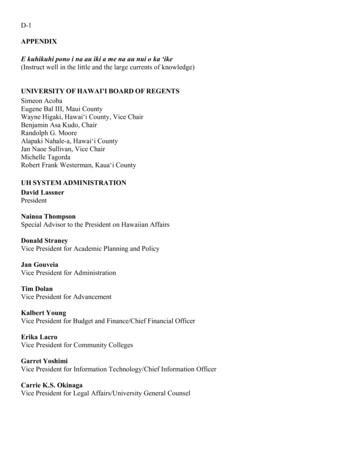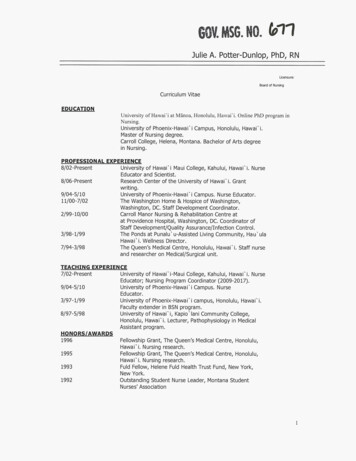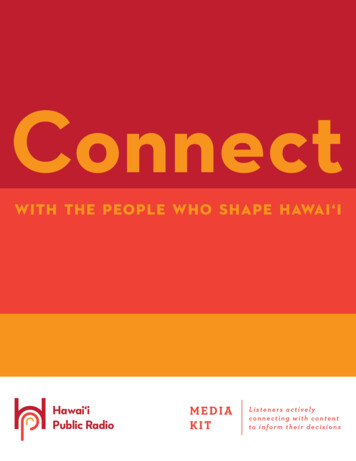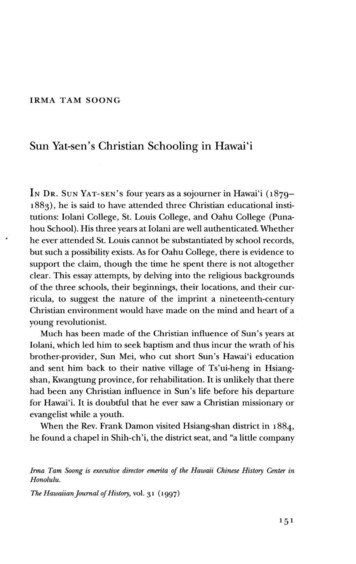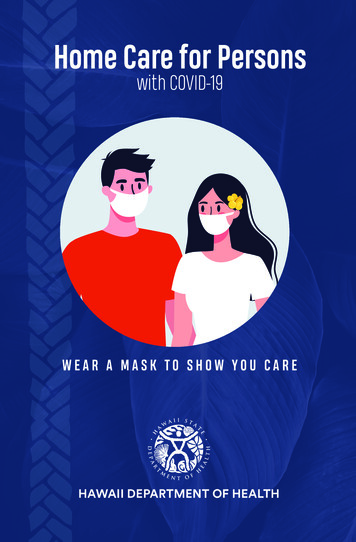
Transcription
Home Care for Personswith COVID-19WEAR A MASK TO SHOW YOU CAREHAWAII DEPARTMENT OF HEALTH
Aloha,Caring for someone with COVID-19 can be challenging. Youare not alone, more than 90% of people in Hawaii who getinfected with COVID-19 get all of their care in their home.That is why it is important that all adults have the knowledgeto provide COVID-19 care for themselves or a loved one intheir home.The State of Hawaii has plenty of help available for you. Thisbooklet provides information to develop a plan for you andyour loved ones when either you or a close family member orfriend is infected with COVID-19. Dialing 2-1-1 on your phonewill connect you to Aloha United Way to gather informationabout available community resources that may help youthrough this time.This booklet does not replace medical advice. Personswith COVID-19 should seek medical advice and carefrom a licensed healthcare provider. If you don’t have ahealthcare provider, this booklet has information for locatingone. Information regarding COVID-19 is being updated asmore is learned about the virus. Updates can be found athawaiicovid19.com.We wish you well and good health!Aloha,Hawaii State Department of HealthWear A Mask to Show You Care3
Table of ContentsDevelop your COVID-19 Plan. 6Contact list of important people. 7Overview of COVID-19. 8Symptoms. 8People at higher risk for severe COVID-19. 9How is the COVID-19 virus spread?. 10Stop the spread of COVID-19.11Why should you follow the recommendations toSTOP COVID-19 from spreading to others?.12Know the difference between isolation and quarantine.13What is Contact Tracing?.15Caring for someone with COVID-19 at home.16COVID-19 Supplies for your Household.16Communicate with the sick person’s healthcareprovider.17If you do not have healthcare provider.17Things to discuss with the healthcare provider.17Isolating at home.18Resources when isolation cannot be achievedin a home.19Choosing the Appropriate Caregiver. 20Caregiver safety while caring for a personwith COVID-19.21Hand Hygiene and Keep Hands off of Face.22Hand washing.22Keeping hands off of your face.23Personal Protective Equipment.24Masks.24Wearing and Cleaning Your Masks.24Putting on and taking off a mask correctly.254Home Care for Persons with COVID-19
Face Shield or Goggles. 26Putting on and taking off face shield orgoggles correctly. 26Disposable Gloves.27To put on gloves correctly.27To take off gloves correctly.27Clean and Disinfect the Home Environment. 29Tips for cleaning and disinfecting. 30Taking Care of the Body, Mind, and Spirit.32Monitoring the Sick Person at Home.32Signs Person with COVID-19 is Getting Sicker. 33How to Take a Temperature. 34Safety and Infection Control:. 34Oral temperature (by mouth). 34Rectal temperature.35Infrared Non-Contact.35How to Take a Pulse and Count Respirations. 36Taking a pulse. 36Counting Respirations.37Pulse Oximeter.37How to use a pulse oximeter. 38Resources. 38Aloha United Way 211. 38Crisis Support, Mental Health or Substance UseTreatment Services. 39Community Health Centers. 39Native Hawaiian Health Care Systems.42Foodbanks.45COVID-19 Isolation and Quarantine Assistance. 46Emergency Medical Services.47Temperature, Breathing, Pulse, and Pulse Oximetry Log. 49Wear A Mask to Show You Care5
Develop your COVID-19 PlanCOVID-19CHECKLISTKey things you need to plan for:6 Educate yourself: Find out what you need to care forsomeone with COVID-19. Consider what you already know and do not know aboutCOVID-19 home care. Make a list of the supplies and equipment necessary forCOVID-19 home care. Understand what you need to tell others that have beenexposed to you. Be a leader in your home. Teach & coach others in yourfamily about COVID-19 home care. The first step to start your COVID-19 plan is to review thisHome Care for Persons with COVID-19 booklet.Home Care for Persons with COVID-19
Contact list of important peopleComplete this form (beforehand) for you and others you mayprovide care for:Healthcare ProviderName: Phone:Address:PharmacyName: Phone:Address:Emergency Contact for Your FamilyName: Relationship:Phone: Email:Family Member that Can Make Decisions for You if NeededName: Relationship:Phone: Email:School(s) that Family Member AttendsName: Phone:Name: Phone:Name: Phone:Family Support (Food, medicines, supplies, etc.)Name: Relationship:Phone: Email:Wear A Mask to Show You Care7
Overview of COVID-19Coronavirus Disease 2019(COVID-19) is caused by a newstrain of coronavirus calledSevere Acute RespiratorySyndrome Coronavirus 2 (SARSCoV-2). Nearly every countryin the world has had cases ofCOVID-19. In Hawaii about7-10% of those who contract thedisease require hospitalization.When a virus changes (mutation), the changed virus is called avariant. Delta is a SARS CoV-2 variant that is more infectious,increasing the spread of COVID-19 to individuals, includingthose that have been vaccinated.»» Fever 100.4 For higher»» Muscle achesand pains8»» Cough»» Vomitingor diarrheaHome Care for Persons with COVID-19»» Shortnessof breath»» Chills»» New loss oftaste or smell»» Sore throat»» Headache»» Fatigue
Symptoms Symptoms of COVID-19:Symptoms appear about 2-14 days after being exposed tothe virus from another person.People can infect others from two days before symptomsappear until 10 days after symptoms start.Many people can have COVID-19 without having anysymptoms and can spread infection to others.Symptoms can range from mild to severe.»» HIV InfectionPeople at higher risk for severeCOVID-19 include: Elderly (65 ) People with:»» Cancer»» Chronic kidney disease»» COPD (chronic bronchitisand emphysema)»» Dementia or otherneurological conditions»» Diabetes Mellitus(Type 1 or 2)»» Down Syndrome»» Heart conditions(heart failure, coronaryartery disease, orcardiomyopathies)»» Immunocompromisedstate (weakenedimmune system)»» Liver disease»» Overweight andobesity»» Pregnancy»» Sickle cell disease»» Smoking (current orformer)»» Stroke»» Substance usedisorders»» Weakened immunesystem from solidorgan or stem celltransplantThis is why it is important to stay healthy and keep chronicdiseases under control during this pandemic. If you smoke orvape, we recommend quitting.Wear A Mask to Show You Care9
How is the COVID-19virus spread?Direct Contact Personto-Person The COVID-19virus spreads from oneperson to another through: Respiratory dropletswhich greatly increaseduring a cough orsneeze or loud speakingor singing (so coveryour mouth whencoughing or sneezing, stay further away from people whoare speaking loudly). Inhaling the air where COVID-19 is floating on very tinydroplets - keep windows open when you can.Indirect Contact A person with COVID-19 touches an objectand leaves the virus on it. Another person touches this area,and then touches their face, permitting the germ to enter thebody through the nose, mouth or eyes.This is why hand washing and cleaning the home environmentis so important! Although the COVID-19 virus can live onsurfaces for several hours or longer, spread from touchingsurfaces is not thought to be a common way that COVID-19spreads.Important note: People who are infected and have nosymptoms can spread it to others by direct contact orindirect contact. They can even be super spreaders(spreading to a large number of people)!10Home Care for Persons with COVID-19
Stop the Spread of COVID-19 STAY at home if you are sick except to getmedical care. Avoid contact with sick people. Frequently wash or sanitize your hands(hand hygiene). Caregiver must always wash their handsafter coming into contact with a familymember who has COVID-19. Keep your hands off your face! Use a face mask. Social distance and avoid crowds. Keep atleast 6 feet away from people who do notlive in your home. Cough etiquette- cover your mouth andnose when you cough or sneeze. Clean / disinfect surfaces in your homewith household disinfectant. Get an annual flu shot to prevent gettingthe flu. Flu and COVID-19 have some ofthe same symptoms which can createconfusion. Flu can also weaken yourimmune system. Get the COVID-19 vaccine. COVID-19vaccines keep you from getting COVID-19.If you do get COVID-19 after beingvaccinated, the vaccine helps you frombeing seriously ill. People are considered tobe fully vaccinated 14 days after receivingthe 2nd dose of the 2-dose series or onedose of the one dose vaccine.Wear A Mask to Show You Care11
Kīnā‘oleDoing the right thing, in the right way, inthe right place, for the right reason, with theright feeling. the first time!Why should you follow the recommendationsto STOP COVID-19 from spreading to others?Keep your family safe and consider what can happenphysically, emotionally, and spiritually if someone in your homegets COVID-19. We must all have the spirit of kīnā‘ole which means wemust all do the right thing! You have the power to prevent spreading COVID-19 to aloved one or friend.»» We can take steps to reduce the possibility of infectingour friends and family. None of us wants to infect loved ones with COVID-19. Doyour part to stay safe and be sensitive to the emotional tollthat COVID-19 is creating in our community. It will take all of us working together (hana pū ‘ana) toprotect our community, families and ourselves.12Home Care for Persons with COVID-19
Know the difference between isolationand quarantineIsolation is for a person who tested positive or was diagnosedwith COVID-19 regardless of vaccination status. You must stay athome or in an isolation facility except to get medical care until: At least 10 days have gone by since symptoms first appearedor if there were no symptoms, since COVID-19 test wastaken AND You have gone at least 24 hours with no fever (without theuse of fever reducing medicines) AND Other symptoms are improving (e.g. cough, shortness ofbreath).You may need to wait up to 20 days if you had a severe case ofCOVID-19 or if you are immunocompromised. Your healthcareprovider should assess this. Do not have close contactwith anyone who lives outside of your home. Unvaccinatedhousehold members are in quarantine.Quarantine is for a contact who is not fully vaccinated* andhas been exposed to someone with COVID-19. This means theperson you came into contact with has COVID-19 symptomsand/or has a positive COVID-19 test (vaccinated or notvaccinated). If you are able to further avoid contact with theCOVID-19 positive person, quarantine is 10 days†. If you are notable to avoid contact, you must stay home while the person withCOVID-19 is in isolation AND for 10 additional days. Consider 14days of quarantine if you might expose someone who is elderly,immunocompromised, or has other risk factors for adverseoutcomes if infected with SARS CoV-2.*People are considered fully vaccinated 2 weeks after receiving their 2nd dosein a 2-dose series or 2 weeks after a single-dose COVID-19 vaccine.†14-day quarantine still applies to congregate settings (e.g., long-term carefacilities, group care homes, assisted living facilities, correctional facilities,shelters, residential rehabilitation and treatment settings, military housing, etc.).Wear A Mask to Show You Care13
Household contacts (close contacts) are people living in thesame house and have ongoing contact with the person withCOVID-19.»» Unvaccinated caregivers and household contacts muststay in quarantine while the family member is sick and for10 days after the household member with COVID-19 isreleased from isolation. This is because you could have beeninfected towards the end of your family member’s illness.Get a COVID-19 test immediately and remain in your homeuntil the quarantine period is over. Get tested again 5-7 daysafter the last contact with the COVID-19 positive person orsooner if symptoms develop.»» Fully vaccinated caregivers and household contactsthat have no symptoms do not have to quarantine, orbe restricted from work.* Fully vaccinated caregiversand contacts should get tested 3-5 days after the lastcontact with the Case, even if there are no symptoms.Continue to wear a mask in public indoor settings for 14days or until you receive a negative test result. They shouldmonitor for symptoms of COVID-19 for 14 days followingthe exposure. Fully vaccinated household contacts andcaregivers that experience COVID-19 symptoms, shouldtest for COVID-19 and isolate if positive.»» All contacts regardless of vaccination status shouldmonitor for symptoms of COVID-19 for 14 days followingthe exposure.»» Caregivers and Contacts regardless of vaccination statusshould use personal protective equipment and adhere toprecautions.Testing but not quarantine is recommended for fully vaccinated contacts,caregivers, employees of correctional and detention facilities and homelessshelters. If you are in one of these groups, you should monitor for symptoms ofCOVID-19 for 14 days following the exposure and test 3-5 days after exposureor sooner if symptoms develop.*14Home Care for Persons with COVID-19
If you do not live with the person with COVID-19 AND do nothave symptoms: Remain at home for 10 days after you were last in closecontact with the person with COVID-19 unless you are fullyvaccinated. Your household contacts do not need to stay home unlessthey test positive or they are ill.For both isolation and quarantine, separate yourself from otherpeople in your home. If you need to be around other people inor outside your home, wear a face mask. Do not use any kind ofpublic transportation, ride sharing, or taxi.What is Contact Tracing?Contact tracing is when a personfrom the Hawaii Department ofHealth or other official organizationcalls you and asks information aboutthe people and places the sick personhas been around. This is to find outwho else may have been exposed tothe person with COVID-19.Alert!Alert!Infected withCOVID-19Alert!Alert!When you get a call from the HawaiiDepartment of Health, we kindly askthat you speak to them on the phone and answer their questions.The information you give the Hawaii Department of Health is neededto stop the virus that causes COVID-19 from spreading to others.It is important to note that Contact Tracing does not replacemedical advice for COVID-19 from your healthcare provider. Thatis why you need to contact your healthcare provider right awayif you suspect you have COVID-19 or are experiencing cough,fever, or loss of your sense of taste or smell that might be due toCOVID-19. If you do not have a healthcare provider, or if you havequestions, call 2-1-1 or visit www.auw211.org. You may also contacta community health center (see page 39).Wear A Mask to Show You Care15
If you have tested positive for COVID-19, make a list of everyonewith whom you have had close contact while you were ill (includefrom 2 days before you were ill or if you have no symptoms, fromtwo days before you had your COVID-19 test). Let them knowthey have been exposed to COVID-19. Remember to kı̄nā‘ole,and call your close contacts.Caring for someone with COVID-19 at homeCOVID-19 Supplies for your HouseholdIt is important to have supplies on hand NOW to PREPARE incase a family member gets sick with COVID-19. Below is a listof recommended COVID-19 supplies for your home.Working thermometerMedicines (medicines you would usually takeand fever medicines)Food (prepared meals and non-perishablefoods). Make plans with family members whocan help with meals and food deliveryCleaning and disinfecting supplies (soap,water, disinfecting wipes, bleach ordisinfectant*)»» *Note: Never clean a surface with straightbleach. Strong bleach fumes can harmyour family’s lungs. Refer to page 30 fordiluting bleach.Soap, alcohol based hand sanitizerMasks, gloves, face shield, gogglesLined trash canBaby supplies, if you have a baby in the home16Home Care for Persons with COVID-19
Pet suppliesEntertainment (cards, games, books, magazines, puzzles,etc. while you isolate or quarantine)Source of communication with others (working cell phoneand charger for telehealth and contacting family andfriends)Communicate with the sick person’s healthcare providerCall their office and let them know that your familymember has tested positive for COVID-19. Ask thehealthcare provider what you should do to care for aperson with COVID-19.Be sure to tell them about chronic health conditions thesick person may have, their age, and vaccination status.If you do not have a healthcare providerIf you do not have a healthcare provider, you can:Call on the Community Health Centers (CHC) across thestate. CHCs see patients regardless of their ability to pay.CHC information is in the back of this booklet.ORCall the Queens Health Systems COVID-19 Infoline at (808)691-2619 (more information for the Queens Health SystemsCOVID-19 Infoline is located at the back this book).ORCall 2-1-1Things to discuss with the healthcare providerCOVID-19 testing and test results for the sick person.Medicines to take for fever or other symptoms.Medical follow up and advice.Wear A Mask to Show You Care17
COVID-19 rules the healthcare provider’s office uses forseeing patients.»» If telehealth is used by the healthcare provider’s office,make sure you have an internet connection.Ask what symptoms you should seek additional care for orwhen to call 911 for the person who is sick.Ask about the number of days the sick person must isolate.Ask about the number of days for quarantine for the directcare provider and for others living in the home.Isolating at homeThe person who tests positive for COVID-19 must:Stay at home unless you need to seek medical care.DO NOT GO TO WORK, SCHOOL OR ANY PUBLIC PLACES(Grocery store, gas station, library, beach, park, etc.) ANDDO NOT USE PUBLIC TRANSPORATION (The Bus, taxi, rideshare such as Uber or Lyft, etc.).DO NOT allow visitors to the home. Fully vaccinated visitorswho are not at risk for serious complications due to COVID-19can visit. Fully vaccinated visitors must wear a face mask.The person with COVID-19 must isolate themselves fromothers in the home.»» Stay in a separate room from others and close thedoor.»» If possible, use a separate bathroom.»» Do not touch shared items in the home that others use(TV remote, countertops, microwave, etc.).»» If the sick person has to be around others, everyone inthe home must wear a face mask.»» Sick person should wear a mask, if they are able totolerate it.18Home Care for Persons with COVID-19
All meals must be eaten in the isolation room away fromothers.Open a window with a fan blowing air outside the house forgood air flow and to decrease the COVID-19 virus in the air.If the person with COVID-19 does not have a separate roomto isolate in, you can create a physical barrier by hanging ashower curtain, sheet, or blanket to create a separate space.Resources when isolation cannot be achieved in a homeThe Hawaii Department of Health has arranged for resources ifthe COVID-19 positive person is not able to adequately isolatein the home.Call Aloha United Way 2-1-1 and ask for an interpreter if youneed one. Let Aloha United Way 2-1-1 know that a familymember has COVID-19 and has no means for isolation inthe home.Put in a request for alternate accommodations. (seeCOVID-19 Isolation and Quarantine Assistance on page 46).Family members will be required to stay away and not visitthe person in isolation until the infected person recoversand comes out of isolation unless they are fully vaccinated.Wear A Mask to Show You Care19
Be sure to take the COVID-19 recommended supplies onpage 16 that you will need before going into isolation awayfrom your home.A family member may be asked to put on a mask and drivethe sick person, who is also masked, to the isolation facilityaway from your home. Car windows should be open asweather permits.Choosing the Appropriate CaregiverIdeally the caregiver should befully vaccinated if not, limit thecaregiver to only one person.One caregiver will decreasethe number of persons beingexposed to the infectedperson. The caregiver muststay home while caring for ahousehold COVID-19 positivefamily member. The caregivermust stay in quarantine for 10 or 14 more days as directed bythe public health representative after the person sick withCOVID-19 meets the criteria to end home isolation. Fullyvaccinated caregivers do not need to quarantine, but shouldtest 3-5 days after beginning care or if symptoms of COVID-19develop. Continue to use personal protective equipment whilecaring for the sick person. This is because the caregiver isconsidered to be exposed to COVID-19.You SHOULD NOT be a caregiver to someone positive forCOVID-19 if you: Are 65 years or older Are immunocompromised Are pregnant20Home Care for Persons with COVID-19
Have one or more underlying high-risk medical conditionsthat are not well controlled, for example:»» Chronic kidney disease»» COPD (chronic bronchitis or emphysema)»» Diabetes Mellitus type 2»» Cardiovascular (heart) diseaseIf any of the above apply to you, you are at high risk for severeillness from COVID-19 or may need extra precautions.Caregiver safety while caring for a person with COVID-19 Keep your hands off your face. Be mindful NOT to touchyour face, nose, or eyes. Wear a mask when in the sick person’sroom or when you are less than 6 feet apart. Wash or sanitize your hands frequently. Wear gloves when handling items thathave been touched by the sick person. Anticipate the sick person’s needs so theydo not have to come out of their room. Keep the sick person’s room wellventilated (window open, fan blowing air tothe outside). Monitor yourself for symptoms of COVID-19.»» Take your temperature two times a day (morning andevening or if new onset of symptoms such as fever,shortness of breath, chest tightness, or difficultybreathing).»» Monitor yourself for cough or shortness of breath. Call your healthcare provider right away if you develop anysymptoms.Wear A Mask to Show You Care21
Hand Hygiene and Keep Hands off of FaceHand washingHand hygiene is one of the most effective ways to preventspreading COVID-19 by direct contact with objects which havethe virus on it. It is important to remember to wash your handsfrequently and correctly. Wash hands before and after providing care to a sickperson. Wash hands with soap and water for at least 20 seconds. If soap and water are not available, use hand sanitizer thathas at least 60% alcohol.22Home Care for Persons with COVID-19
Keeping hands off of your faceDid you know that the average person touches their face orhair about 20 times in one hour? Germs on your hands get onto your face and can enteryour body through the eyes, nose, or mouth. Be mindful of face touching.Some tips to help with keeping your hands off of your face are: Ask a friend to tell you when you touch your face. Remind others when you see them touching their face. Keep your hands busy by putting them in your pocketor hold something in your hand. Sit on your hands. RelaxWear A Mask to Show You Care23
Personal Protective EquipmentMasksWhy should you wear amask? A mask can trapthe droplets from the sickperson and protect ourloved ones and friends.Wearing the right mask isimportant. Masks shouldhave two or more layers ofbreathable and washablecloth. Masks shouldcompletely cover your nose and mouth. Masks should fit snuglyagainst the sides of your face and there should be no gaps.Wearing and Cleaning Your Masks Always wear a mask when in the same room as the sickfamily member. Ask the sick person to also wear a mask when you are inthe room. Change your mask if it becomes soiled, breaks, or becomeswet. Store your mask in a paper bag or hang in the sunlight. You can wash cloth masks in the laundry, try to use hotwater and if available, put in the dryer on high heat. Be sure to properly put on and take off the mask. ALWAYS wash your hands before and after putting on ortaking off a face mask. The outside of the mask may havethe virus on it.24Home Care for Persons with COVID-19
Putting on and taking off a maskcorrectlyTo put on a mask correctly: First wash your hands. IF you are reusing a mask, Do NOT touch themask cloth, only touch the ear loops or strings. Mask with ear loops:»» Hold the mask by the loops and slipover the ears.»» Be sure the mask covers the nose,mouth and hugs under the chin. Mask with strings:»» Tie the top strings first.»» Using the bottom ties, pull the maskover your nose and mouth to under thechin.»» Tie the bottom strings.To take off a mask correctly: IF reusing the mask, have a paper bag readyand open so you can drop the mask intoit and immediately wash your hands. If you do not have apaper bag, a breathable container can be used. DO NOT touch the cloth of the mask, only the ear loops orstrings. Mask ear loops:»» Grab loops behind the ears with both hands.»» Pull off the mask and drop into the paper bag. Mask with strings:»» Untie the bottom tie.»» Untie the top tie keeping the top ties in your fingers.»» Drop the mask into the bag.»» Wash your hands.Wear A Mask to Show You Care25
Face Shield or GogglesIf the person you are caring for has a cough, you can alsoconsider wearing a face shield or goggles. Wearing a faceshield or goggles can help to prevent respiratory droplets fromlanding in your eyes. Be sure to wear your mask with your faceshield or goggles.Putting on and taking off face shield or goggles correctly:To put on a face shield or goggles: First follow the steps to put on the mask. Put on the face shield or goggles after you put on the mask.To take off a face shield or goggles: Remove the face shield or goggles. Remove your mask. Wash your hands.26Home Care for Persons with COVID-19
Disposable GlovesAlways wear gloves when you touch your family member withCOVID-19 or handle any of their things such as dinnerware,sheets, and clothing. Use gloves when cleaning any areawhere your sick fami
Wear A Mask to Show You Care 3 Aloha, Caring for someone with COVID-19 can be challenging. You
